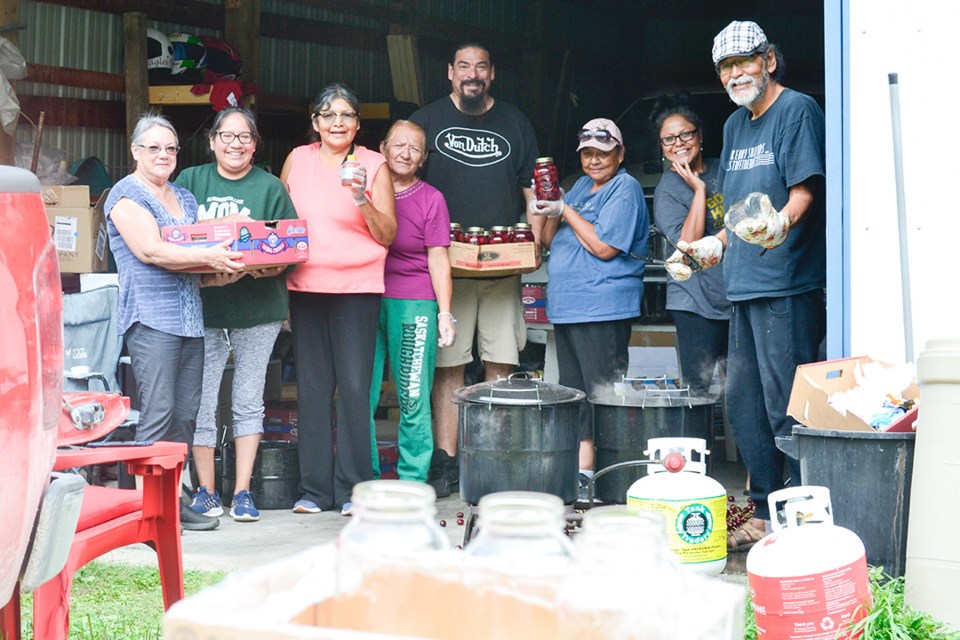White Bear First Nations councillor Bernie Shepherd is the chief cook and bottle prepper at the canning class he is conducting.
The White Bear First Nations has an abundance of wild berries that grow naturally in the forested landscape located in the southeast of Saskatchewan and has provided locals and those visiting the area with bountiful berry picking seasons.
This year the saskatoons were plentiful and berry picking was an activity that many took part in.
With such a large quantity of berries many of the berries get frozen or canned to enjoy through the fall and winter months, or however long they last, so a canning class was offered to help those preserve the berries.
This year, because of the pandemic, most people have stockpiled anything and everything and food is one of those items. It is always good to have plenty in the pantry and freezer.
The chief and council at White Bear First Nation have made several plans to ensure there is no break in the food supply chain since the uncertainty of the pandemic first presented itself.
Shepherd had taught a canning class at the end of July for those that wanted to can saskatoons, so they can learn how to preserve the extra berries.
The class was well received by those attending, which also spawned another careful plan to hold another canning class on Aug. 20 and 21, again under Shepherd’s instruction with veterans Jackie Maxie, Leanne Istach, Fonda Shepherd and Debbie Shepherd of the earlier class who came to assist with the undertaking.
For this class, the White Bear First Nation acquired 1,000 pounds of B.C. cherries, which were picked up by Edward LittleChief at an orchard near Kelowna and transported back to Shepherd’s for the canning class.
Shepherd supplied use of his shop, the equipment consisting of two 30,000 British thermal unit burners, large cauldrons and cooling shelves. The supplies were looked after by the White Bear First Nation.
The canning process takes on an almost assembly line like character with several steps that all need to culminate together at the end for the finished product.
The propane burners provide the heat for the cauldrons, which are used to prepare the syrup, sterilize the jars and to also heat the lids which have a rubber seal which seals best if heated till it softens, making for a perfect seal. The syrup is made from water, lemon juice and honey, which is used instead of white sugar to make for a completely natural product.
Two of the veterans were tasked with destemming all the cherries, which are then washed and ready for the procedure.
The sealer is then partially filled with a cup of syrup and the berries are placed in, filling it to about a half inch from the top, leaving the necessary headroom in the jar for the lid, which is wiped dry, put in place and secured.
The jar is then immersed in one of the cauldrons, which have the capacity for eight units, for 25 minutes creating a tight seal, and then moved to the cooling shelves.
The canning procedure continues till all the cherries are used up and ready for distribution.
The veterans and Shepherd canned 32 jars on a test run the night before class to work out any issues in the canning process and then held the first class on Aug. 20, canning 192 one-litre units.
The second day of the class they were shooting for at least that, knowing that by days end all the fruits of their labours would be on the cooling shelves, producing another 292 one-litre jars.
The class was a great success with approximately 260 jars still to fill; each person in the class got to take home a tasty treat for their pantry and the First Nation will distribute the canned cherries throughout their community at the direction of chief and council, beginning with the elders.
There will also be a need to can vegetables in the coming weeks as the First Nation also made plans early in the spring, encouraging the citizens of White Bear First Nations to plant several gardens around the community and it has been a good year for growing vegetables, providing for an abundant harvest as well.



